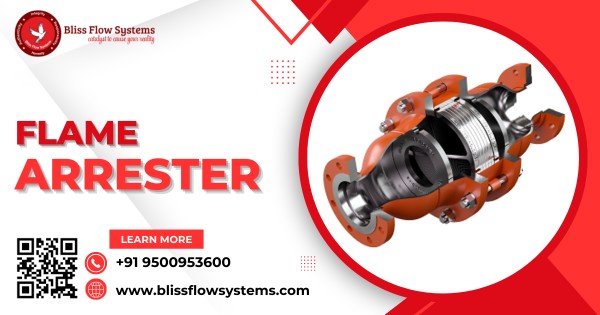


Bliss flow systems are Supplier & #distributor of Flame Arresters
A flame arresters a safety device that is fitted to the opening of an enclosure, or to the connecting pipe work of a system of enclosures, and whose intended function is to allow flow but prevent the transmission of flame in the event an ignition takes place.
Flame arresters are typically used wherever there is the potential for an explosion arising from flammable gas or vapor being mixed with air. Accidental ignition of a flammable mixture will result in a flame that will travel through the unburnt mixture until the fuel is consumed by the reaction.
Flame arrestors stop the flame propagation from entering through an opening. The device contains an assembly of perforated plates, slots, screens, etc. enclosed in a case or frame that will absorb the heat of a flame entering and thereby extinguish it before it can pass through.
The portion of a deflagration arrester or detonation arrester comprised of parallel spaced plates, packed ceramic or steel bed, stacked or rolled expanded metal or crimped metal windings. The element provides the heat sink and mechanical barrier to flame passage.
A flame arrester functions by absorbing the heat from a flame front thus dropping the burning gas/air mixture below its auto-ignition temperature; consequently, the flame cannot survive. The heat is absorbed through channels (passages) designed into an element.
The arrestor is generally made of wound crimped metal ribbon. The metal absorbs the heat from the flame passing through it. This reduces the temperature of the flame to below its autoignition temperature at which point the flame goes out.
Deflagration, Detonation and explosion tests for flame arresters are performed using propane. Some flame arresters pass detonation test but fails in deflagration test. If the process gas increases the rate of combustion, additional tests using the specific process gas are warranted.
What are the common failure modes of flame arresters and how can they be mitigated?
The failures of flame arrestors are typically in four areas: arrestors used under conditions that exceeded their test limitations, arrestors not subjected to any official testing (hence test limitations were not known and likely inadequate for the application), arrestors failing due to their channels being distorted by the flame front overpressure, and failures due to structural or design flaws that allowed a flame pathway through the element. A fifth failure mechanism would be foreign material fouling the arrestor flow channels. Arrestors do fail, so experience data was sought to quantify a failure on demand value.
What safety considerations should be taken into account when installing and operating flame arresters?
The flame arrestor is typically installed about 30 pipe diameters or 5 m upstream of the vent tip. Velocity flame arrestors must not be too far from the ignition source otherwise the flame that is traveling backward may accelerate such that its velocity is sufficient to pass through the arrestor.
Blockage of element with debris
Corrosion.
Mechanical damage.
